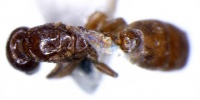Rhopalomastix mazu
| Rhopalomastix mazu | |
|---|---|

| |
| Scientific classification | |
| Kingdom: | Animalia |
| Phylum: | Arthropoda |
| Class: | Insecta |
| Order: | Hymenoptera |
| Family: | Formicidae |
| Subfamily: | Myrmicinae |
| Tribe: | Crematogastrini |
| Genus: | Rhopalomastix |
| Species: | R. mazu |
| Binomial name | |
| Rhopalomastix mazu Terayama, 2009 | |
Nothing is known about the biology of Rhopalomastix mazu.
Identification
Terayama (2009) - Small species; total body length 2.1 mm in female; subpetiolar process developed, higher than long, bearing acute triangle.
Although the female of Rhopalomastix omotoensis from Japan is not yet known, this species is distinctly smaller and has a well developed subpetiolar process (subpetiolar process low, longer than high, with an anteroventral angle in omotoensis worker).
Distribution
Distribution based on Regional Taxon Lists
Oriental Region: Taiwan (type locality).
Distribution based on AntMaps
Distribution based on AntWeb specimens
Check data from AntWeb
Countries Occupied
| Number of countries occupied by this species based on AntWiki Regional Taxon Lists. In general, fewer countries occupied indicates a narrower range, while more countries indicates a more widespread species. |

|
Estimated Abundance
| Relative abundance based on number of AntMaps records per species (this species within the purple bar). Fewer records (to the left) indicates a less abundant/encountered species while more records (to the right) indicates more abundant/encountered species. |

|
Biology
Castes
Known only from the queen caste.
Nomenclature
The following information is derived from Barry Bolton's Online Catalogue of the Ants of the World.
- mazu. Rhopalomastix mazu Terayama, 2009: 191, figs. 271-273 (q.) TAIWAN.
Unless otherwise noted the text for the remainder of this section is reported from the publication that includes the original description.
Description
Queen
Holotype alate. HL 0.35, HW 0.29, SL 0.21, WL 0.42, PNL 0. 11, PH 0.15, DPW 0.16, PPL 0.08, PPH 0.10, PPW 0.14, TL 2.1.
Head rectangular, 1.10 times as long as wide, with almost straight posterior margin and parallel sides in full face view. Anterior margin of clypeus weakly convex. Compound eye 0.18 mm in maximum diameter. Antenna 10-segmented; scape short and flat, SI = 37; 3rd to 9th segments each wider than long; terminal segment large and flat, 0.18 mm long and 1.7 times as long as wide.
Alitrunk long, with flat dorsum; posterolateral corner of propodeum dully angulate. Petiole short and high; peduncle short, node trapezoidal, with anterodorsal and posterodotsal corners; anterior margin straight, dorsal margin almost straight; in dorsal view, dorsal disc wider than long, with convex anterior margin and straight posterior margin; subpetiolar process developed, higher than long, bearing acute triangle. Postpetiole slightly higher than long, and shorter than petiole.
Femora flat and broad, fore femur twice as long as wide, middle and hind femora each 1.6 times as long as wide.
Color. Brown.
Type Material
Holotype. Worker, Taidong City, 20.viii.1980, M. Terayama leg. NAIES
Etymology
The specific epithet is the Chinese noun Mazu, which is the name of a Taiwanese goddess.
References
References based on Global Ant Biodiversity Informatics
- Guénard B., and R. R. Dunn. 2012. A checklist of the ants of China. Zootaxa 3558: 1-77.
- Terayama M. 2009. A synopsis of the family Formicidae of Taiwan (Insecta: Hymenoptera). Research Bulletin of Kanto Gakuen University. Liberal Arts 17:81-266.
- Terayama Mamoru. 2009. A synopsis of the family Formicidae of Taiwan (Insecta, Hymenoptera). The Research Bulletin of Kanto Gakuen University 17: 81-266.
- Terayama, M. 2009. A synopsis of the family Formicidae of Taiwan (Insecta; Hymenoptera). The Research Bulletin of Kanto Gakuen University 17: 81-266.

